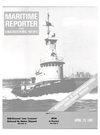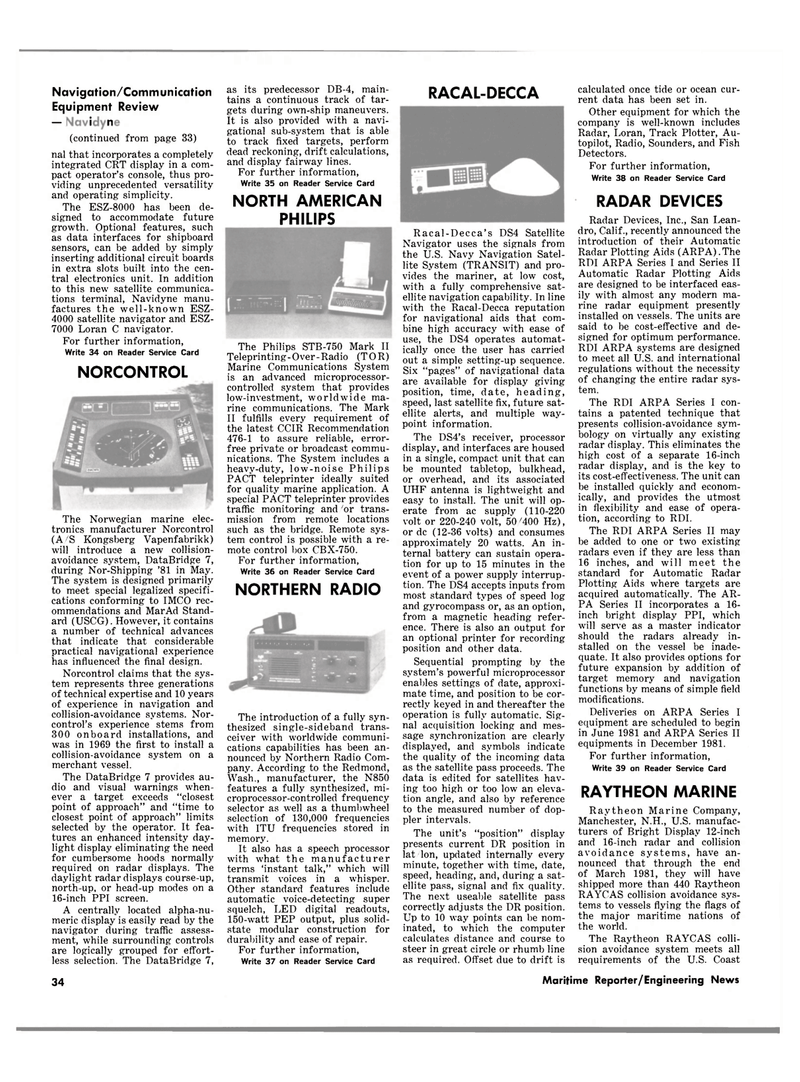
Page 32: of Maritime Reporter Magazine (April 15, 1981)
Read this page in Pdf, Flash or Html5 edition of April 15, 1981 Maritime Reporter Magazine
Navigation/Communication
Equipment Review — Scientific Atlanta (continued from page 33) nal that incorporates a completely integrated CRT display in a com- pact operator's console, thus pro- viding unprecedented versatility and operating simplicity.
The ESZ-8000 has been de- signed to accommodate future growth. Optional features, such as data interfaces for shipboard sensors, can be added by simply inserting additional circuit boards in extra slots built into the cen- tral electronics unit. In addition to this new satellite communica- tions terminal, Navidyne manu- factures the well-known ESZ- 4000 satellite navigator and ESZ- 7000 Loran C navigator.
For further information,
Write 34 on Reader Service Card
NORCONTROL
The Norwegian marine elec- tronics manufacturer Norcontrol (A/S Kongsberg Vapenfabrikk) will introduce a new collision- avoidance system, DataBridge 7, during Nor-Shipping '81 in May.
The system is designed primarily to meet special legalized specifi- cations conforming to IMCO rec- ommendations and MarAd Stand- ard (USCG). However, it contains a number of technical advances that indicate that considerable practical navigational experience has influenced the final design.
Norcontrol claims that the sys- tem represents three generations of technical expertise and 10 years of experience in navigation and collision-avoidance systems. Nor- control's experience stems from 300 onboard installations, and was in 1969 the first to install a collision-avoidance system on a merchant vessel.
The DataBridge 7 provides au- dio and visual warnings when- ever a target exceeds "closest point of approach" and "time to closest point of approach" limits selected by the operator. It fea- tures an enhanced intensity day- light display eliminating the need for cumbersome hoods normally required on radar displays. The daylight radar displays course-up, north-up, or head-up modes on a 16-inch PPI screen.
A centrally located alphanu- meric display is easily read by the navigator during traffic assess- ment, while surrounding controls are logically grouped for effort- less selection. The DataBridge 7, as its predecessor DB-4, main- tains a continuous track of tar- gets during own-ship maneuvers.
It is also provided with a navi- gational sub-system that is able to track fixed targets, perform dead reckoning, drift calculations, and display fairway lines.
For further information,
Write 35 on Reader Service Card
NORTH AMERICAN
PHILIPS
The Philips STB-750 Mark II
Teleprinting-Over-Radio (TOR)
Marine Communications System is an advanced microprocessor- controlled system that provides low-investment, worldwide ma- rine communications. The Mark
II fulfills every requirement of the latest CCIR Recommendation 476-1 to assure reliable, error- free private or broadcast commu- nications. The System includes a heavy-duty, low-noise Philips
PACT teleprinter ideally suited for quality marine application. A special PACT teleprinter provides traffic monitoring and 7or trans- mission from remote locations such as the bridge. Remote sys- tem control is possible with a re- mote control box CBX-750.
For further information,
Write 36 on Reader Service Card
NORTHERN RADIO
The introduction of a fully syn- thesized single-sideband trans- ceiver with worldwide communi- cations capabilities has been an- nounced by Northern Radio Com- pany. According to the Redmond,
Wash., manufacturer, the N850 features a fully synthesized, mi- croprocessor-controlled frequency selector as well as a thumbwheel selection of 130,000 frequencies with ITU frequencies stored in memory.
It also has a speech processor with what the manufacturer terms 'instant talk," which will transmit voices in a whisper.
Other standard features include automatic voice-detecting super squelch, LED digital readouts, 150-watt PEP output, plus solid- state modular construction for durability and ease of repair.
For further information,
Write 37 on Reader Service Card
RACAL-DECCA
Racal-Decca's DS4 Satellite
Navigator uses the signals from the U.S. Navy Navigation Satel- lite System (TRANSIT) and pro- vides the mariner, at low cost, with a fully comprehensive sat- ellite navigation capability. In line with the Racal-Decca reputation for navigational aids that com- bine high accuracy with ease of use, the DS4 operates automat- ically once the user has carried out a simple setting-up sequence.
Six "pages" of navigational data are available for display giving position, time, date, heading, speed, last satellite fix, future sat- ellite alerts, and multiple way- point information.
The DS4's receiver, processor display, and interfaces are housed in a single, compact unit that can be mounted tabletop, bulkhead, or overhead, and its associated
UHF antenna is lightweight and easy to install. The unit will op- erate from ac supply (110-220 volt or 220-240 volt, 50/400 Hz), or dc (12-36 volts) and consumes approximately 20 watts. An in- ternal battery can sustain opera- tion for up to 15 minutes in the event of a power supply interrup- tion. The DS4 accepts inputs from most standard types of speed log and gyrocompass or, as an option, from a magnetic heading refer- ence. There is also an output for an optional printer for recording position and other data.
Sequential prompting by the system's powerful microprocessor enables settings of date, approxi- mate time, and position to be cor- rectly keyed in and thereafter the operation is fully automatic. Sig- nal acquisition locking and mes- sage synchronization are clearly displayed, and symbols indicate the quality of the incoming data as the satellite pass proceeds. The data is edited for satellites hav- ing too high or too low an eleva- tion angle, and also by reference to the measured number of dop- pler intervals.
The unit's "position" display presents current DR position in lat/lon, updated internally every minute, together with time, date, speed, heading, and, during a sat- ellite pass, signal and fix quality.
The next useable satellite pass correctly adjusts the DR position.
Up to 10 way points can be nom- inated, to which the computer calculates distance and course to steer in great circle or rhumb line as required. Offset due to drift is calculated once tide or ocean cur- rent data has been set in.
Other equipment for which the company is well-known includes
Radar, Loran, Track Plotter, Au- topilot, Radio, Sounders, and Fish
Detectors.
For further information,
Write 38 on Reader Service Card
RADAR DEVICES
Radar Devices, Inc., San Lean- dro, Calif., recently announced the introduction of their Automatic
Radar Plotting Aids (ARPA).The
RDI ARPA Series I and Series II
Automatic Radar Plotting Aids are designed to be interfaced eas- ily with almost any modern ma- rine radar equipment presently installed on vessels. The units are said to be cost-effective and de- signed for optimum performance.
RDI ARPA systems are designed to meet all U.S. and international regulations without the necessity of changing the entire radar sys- tem.
The RDI ARPA Series I con- tains a patented technique that presents collision-avoidance sym- bology on virtually any existing radar display. This eliminates the high cost of a separate 16-inch radar display, and is the key to its cost-effectiveness. The unit can be installed quickly and econom- ically, and provides the utmost in flexibility and ease of opera- tion, according to RDI.
The RDI ARPA Series II may be added to one or two existing radars even if they are less than 16 inches, and will meet the standard for Automatic Radar
Plotting Aids where targets are acquired automatically. The AR-
PA Series II incorporates a 16- inch bright display PPI, which will serve as a master indicator should the radars already in- stalled on the vessel be inade- quate. It also provides options for future expansion by addition of target memory and navigation functions by means of simple field modifications.
Deliveries on ARPA Series I equipment are scheduled to begin in June 1981 and ARPA Series II equipments in December 1981.
For further information,
Write 39 on Reader Service Card
RAYTHEON MARINE
Raytheon Marine Company,
Manchester, N.H., U.S. manufac- turers of Bright Display 12-inch and 16-inch radar and collision avoidance systems, have an- nounced that through the end of March 1981, they will have shipped more than 440 Raytheon
RAYCAS collision avoidance sys- tems to vessels flying the flags of the major maritime nations of the world.
The Raytheon RAYCAS colli- sion avoidance system meets all requirements of the U.S. Coast 34 Maritime Reporter/Engineering News

 31
31

 33
33
